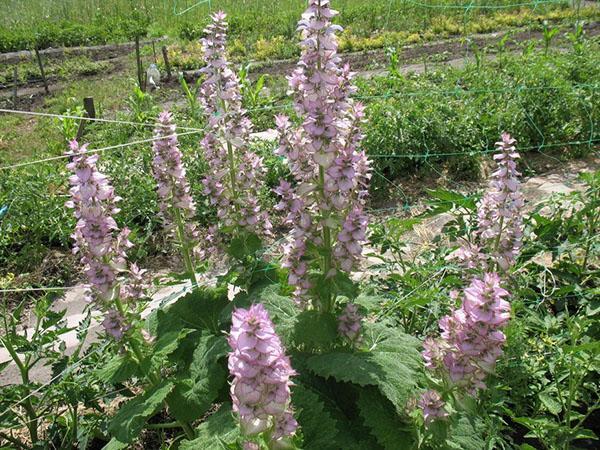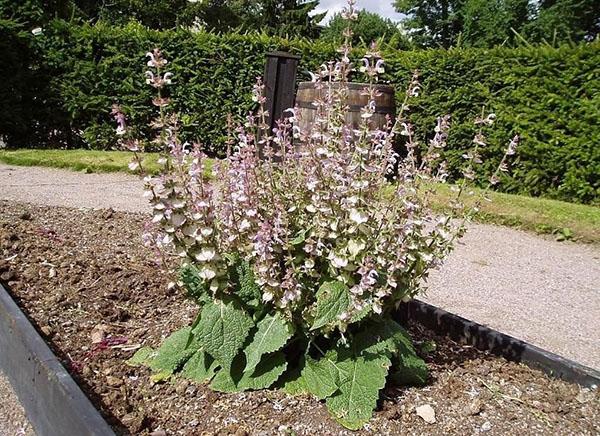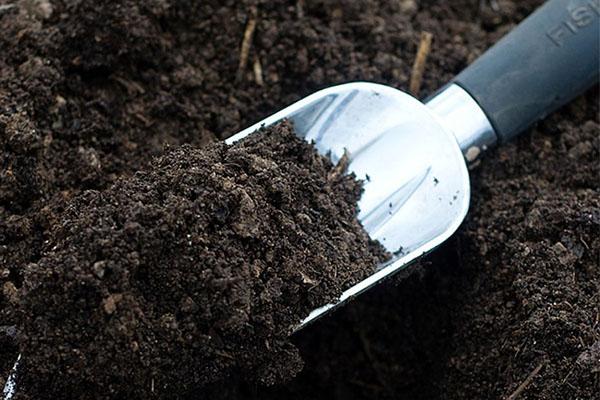Growing clary sage from sowing to harvest

At the summer cottage, growing clary sage is not difficult at all. The aromatic herb is in great demand all over the world. This plant is widely used as a seasoning in cooking. Fragrant foliage complements wines, tobacco blends, liqueurs well. From the entire aerial part, an essential oil is obtained, which the plant is rich in. It is used for food and cosmetic purposes. If there is a free piece of land in your summer cottage, be sure to plant sage there.
Clary sage: growing on the site

Clary sage is the closest relative of all the familiar medicinal sage. The plant is a semi-shrub, more often an annual or biennial plant. It reaches a height of 1.5 m. Prefers warmth and a lot of light, so it responds calmly to dry weather. Period flowering is about a month, it occurs in summer. The flowers are quite large, more often lilac or pink shades, less often white. After flowering in September sage fruits are formed, resembling nuts, only small up to 3 mm in length and wrinkled.
Choosing a territory for growing sage
It is best to choose the beds that are located in the southern part suburban area. The area for the plant should be well lit. If you grow sage in the shade, then it will have very small foliage, and the stem will elongate.
Lack of light can lead to disease.
The optimum daily temperature for good sage growth is +19 - +210C. Despite this, the plant does not freeze even at -300FROM. The main thing is that his bed is protected from drafts and strong winds.
Sage soil

As for the soil, sage is unpretentious in this. It is planted even on poor and saline soils. In this case, the plant will not be lush, but the concentration of the essential oil will remain high. With good moisture and soil fertility, the plant will bloom in large inflorescences.
Only loose buds contain approximately 0.3% essential oils.
The specifics of growing from seeds

Essential oil crops are usually grown from seeds. Less often use the method of dividing the bush.
With the seed method, you can:
- let the plant reproduce due to self-seeding;
- sow it in autumn or spring;
- grow with seedlings.
It is best to sow salvia in the fall from seed obtained in the same season. To do this, choose a strong two-year-old specimen. When 70% of the seeds are ripe. The inflorescences are harvested, then hung to dry completely, with a sheet of paper to collect the loose grains. After they are removed from the inflorescences, they must be sieved and dried. 1-1.5 weeks before planting, the soil in the garden is carefully dug in, cleaned of weeds.
It is also necessary to add top dressing: for each square meter, 1-2 buckets of compost or humus. It is also recommended to use mixtures with phosphoric and potassium mineral salts (20-30 g each). Seeds are sown towards the end of October or early November. Gaps of 0.5 m are left between the rows, the depth of the furrows is small - up to 2 cm.
Sowing time should be chosen carefully. It is most favorable to plant sage before the onset of frost, otherwise the grains will have time to sprout, which will die from frost.
If it is planned to sow in the spring immediately on the beds without pre-growing seedlings, then a week before the procedure, the seeds are placed in wet sand and kept indoors in warm conditions (at a temperature of +22 - +250FROM). As soon as the first white sprouts appear, the sage is transplanted into open ground to a depth of 3 to 4 cm. The distance between rows should be within 30-45 see The area with sage is covered with a film. The space between the rows is periodically loosen and remove all weeds.
Seedling propagation rules

In addition to sowing, clary sage can be propagated by seedlings. Closer to the end of March, its seeds are preliminarily kept in slightly warm water. They are given several days for germination, and then they are sown in separate containers, deepening by 1 cm. The container is kept in a greenhouse or covered with transparent glass. Sage shoots will appear in 25-30 days. Then the greenhouse is removed, the seedlings are thinned out and they begin to harden it. To do this, put the container on the street for an hour, constantly increasing the time.

In the third decade of May, seedlings are planted in the beds or in the garden using a two-line scheme. The distance between individual specimens is 20 cm, between individual rows 20 cm, between strips 0.5 m.
Clary sage care

Watering rules. The culture is demanding on humidity up to exactly until it blooms. After that, calmly endures a short drought. However, it is better to water the plant a little and regularly.
Overflow is destructive for sage.
Soil care. Loose the soil between the rows 3-4 times a season. The first time the procedure is carried out with the onset of March to a depth of 10 cm. loosening is carried out as needed. Such a procedure will improve admission air into the soil.
Salvia does not like weeds, they need to be removed. For the winter plant cover with dry foliage or spruce branches.

Fertilizers for clary sage. The fragrant plant is fed in the spring, minerals are added or manure... For every m2 the beds are added 13-15 g of ammonium sulfate mixed with superphosphate (20 g) and potassium salts (10 g).
When and how to prune a plant. The vast majority of essential oil plants that bloom profusely should be pruned. Sage is no exception. If its inflorescences are separated and dried, then the plant does not require further trimming. If this is not done, then in early spring or already in the fall before wintering at the level of 10-15 cm from the ground, the stems are cut. Two year olds need pruning copies.

Sage is a culture that you should definitely start in your summer cottage. There are many varieties of it, so everyone can choose the best option for themselves and use it for cosmetic, culinary or medicinal purposes.